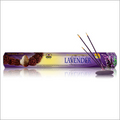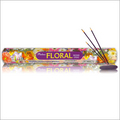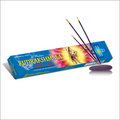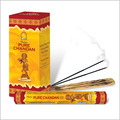 |
Types of Incense |
 |
|
|
|
|
|
 |
 |
|
|
|
|
|
|
|
|
|
|
|
|
 |
Celebration of Fragrance |
 |
|
|
|
|
|
|
|
|
|
|
|
|
|
|
|
|
|
|
|
|
|
| |
| Padma Perfumery Works Replenish your senses! |
| Rose Incense |
White Musk Incense |
Al Oudh Incense |
Sheik Al Arab Blue |
Jasmine Incense |
|
|
|
|
|
 |
 |
 |
 |
 |
|
|
|
Ambergris
Ambergris is a source of rare perfumery substance known for the complexities associated with its production. It is produced in the hindgut of the sperm whales and released in the oceans as excreta. Its perfumery properties defies the common wisdom about pathological substances, which is hard to believe that excreta can produce pleasant, mild and soothing fragrance. It is produced due to the irritation caused by the parrot-like beaks of squid which is a staple food for whales. Constant friction inside the hindgut of whales secretes a foul-smelling liquid.
In the gut of the whale, ambergris is black, semi-viscous and foul-smelling liquid. Once it gets exposed to sunlight and air, it quickly oxidizes and hardens to become a pleasantly aromatic, marbled, grayish, waxy, pellucid substance that still contains squid beaks. Upon warming, it produces a very pleasant, mild, sweet, mesmerizing and earthy aroma. It's fragrance is very strong and can last not only for days or months but for years.
Historical Significance of Ambergris
Almost every civilization on the earth has a brush with Ambergris. Before 1,000 AD, the Chinese names ambergris as lung sien hiang, "dragon's spittle perfume," as they think that it was produced from the drooling of dragons sleeping on rocks at the edge of a sea. The Japanese have also known ambergris for many centuries and termed it kunsurano fuu meaning "whale droppings." The Arabs knew ambergris as anbar who believed that it is produced from springs near seas. The Greeks also thought on the lines of Arabs. They believed that it increases the effects of alcohol when smelled prior to drinking wine. For centuries, this substance has also been used as a flavouring for food. During the Middle Ages, Europeans used ambergris as a remedy for headaches, colds, epilepsy, and other ailments.
Uses of Ambergris
Ambergris releases strong fragrance that are used for various purposes. It can be used in incense sticks besides several other applications. It possesses medicinal values as well and act as a natural aphrodisiac.
Ambergris has been mostly known for its use in creating perfume and fragrance much like musk. While perfumes can still be found with ambergris around the world, American perfumers usually avoid it because of legal ambiguities. It was banned from use in many countries in the 1970s, including the United States, because its precursor originates from the sperm whale, which is an endangered species.[citation needed] However, it has been legal since 2005 because of strict monitoring of distributors who ensure that only ambergris that has been naturally washed to shore is sold. Ancient Egyptians burned ambergris as incense, while in modern Egypt ambergris is used for scenting cigarettes.[2] The ancient Chinese called the substance "dragon's spittle fragrance".[3] During the Black Death in Europe, people believed that carrying a ball of ambergris could help prevent them from getting the plague. This was because the fragrance covered the smell of the air which was believed to be the cause of plague.
This substance has also been used historically as a flavouring for food, and some people consider it an aphrodisiac. During the Middle Ages, Europeans used ambergris as a medication for headaches, colds, epilepsy, and other ailments.
Ambergris has been prized for centuries for its peculiar qualities. It has been used in the perfume industry as a fixative for fine perfumes, for medicinal purposes and as an aphrodisiac. Some people swear by the sensual effects created by rubbing a piece of ambergris on the skin. Ambergris releases pheromones making it a true aphrodisiac, a property which has lead to the mystery and sensuality surrounding the product. Ambergris has also been used to enhance the flavours of food and wine and for herbal and homeopathic remedies.
Ambergris (Ambra grisea, Ambre gris, ambergrease, or grey amber) is a solid, waxy, flammable substance of a dull gray or blackish color produced in the digestive system of and regurgitated by sperm whales.
Freshly produced ambergris has a marine, fecal odor. However, as it ages, it acquires a sweet, earthy scent commonly likened to the fragrance of rubbing alcohol without the vaporous chemical astringency. The principal historical use of ambergris was as a fixative in perfumery, though it has now been largely displaced by synthetics.
Source
Ambergris occurs as a biliary secretion of the intestines of the sperm whale and can be found floating upon the sea, or in the sand near the coast. It is also sometimes found in the abdomens of whales. Because giant squids' beaks have been found embedded within lumps of ambergris, scientists have theorized that the whale's intestine produces the substance as a means of easing the passage of hard, sharp objects that the whale might have inadvertently eaten.
Ambergris is usually passed in the fecal matter. Ambergris that forms a mass too large to exit via the anus is expelled via the mouth, leading to the reputation of ambergris as primarily coming from whale vomit.
Ambergris can be found in the Atlantic Ocean and on the coasts of Brazil, Madagascar the East Indies, The Maldives, China, Japan, India, Australia, New Zealand, and the Molucca islands. Most commercially collected ambergris comes from The Bahamas in the Caribbean, particularly New Providence.
Physical Properties
Ambergris is found in lumps of various shapes and sizes, weighing from 15 g (½ oz) to 50 kg (100 pounds) or more. When initially expelled by or removed from the whale, the fatty precursor of ambergris is pale white in color (sometimes streaked with black), soft, with a strong fecal smell. Following months to years of photo-degradation and oxidation in the ocean, this precursor gradually hardens, developing a dark gray or black color, a crusty and waxy texture, and a peculiar odor that is at once sweet, earthy, marine, and animalic. Its smell has been generally described as a vastly richer and smoother version of isopropanol without its stinging harshness.
In this developed condition, ambergris has a specific gravity ranging from 0.780 to 0.926. It melts at about 62 °C to a fatty, yellow resinous liquid; and at 100 °C (212 °F) it is volatilized into a white vapor. It is soluble in ether, and in volatile and fixed oils.
Chemical properties
Ambergris is relatively nonreactive to acid. White crystals of a substance called ambrein can be separated from ambergris by heating raw ambergris in alcohol, then allowing the resulting solution to cool.
Historical and cross-cultural uses
This substance has also been used historically as a flavouring for food, and some people consider it an aphrodisiac. During the Middle Ages, Europeans used ambergris as a medication for headaches, colds, epilepsy, and other ailments.
|
|
|









